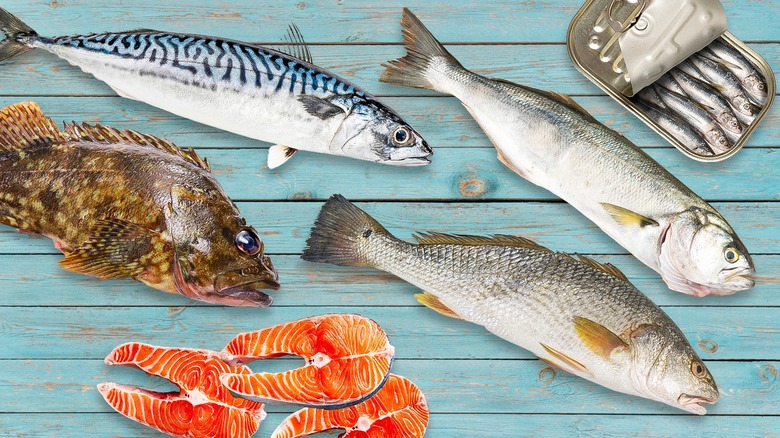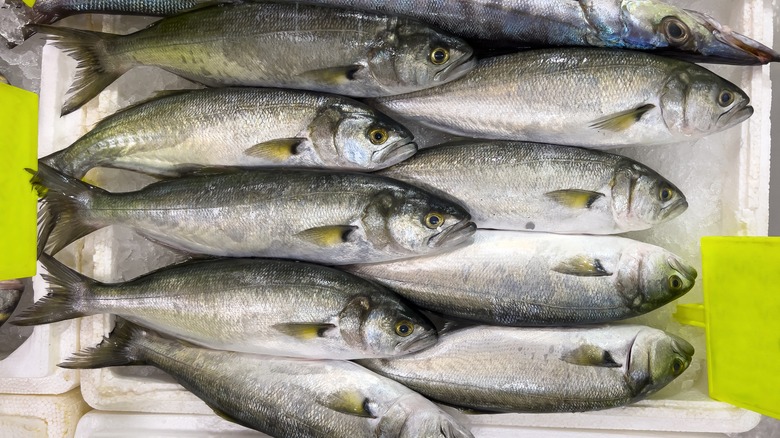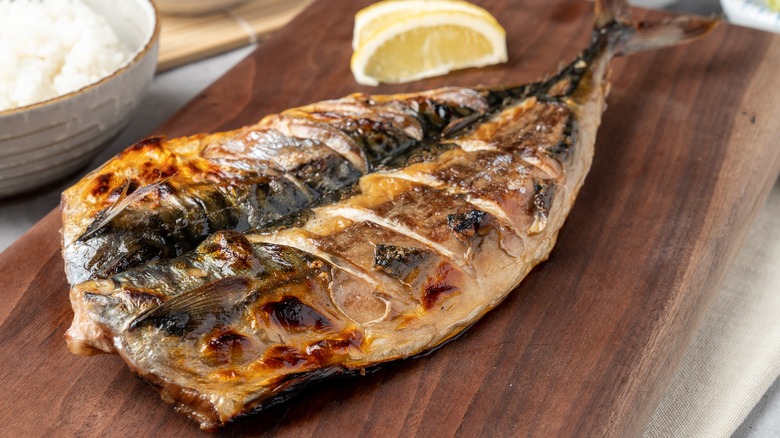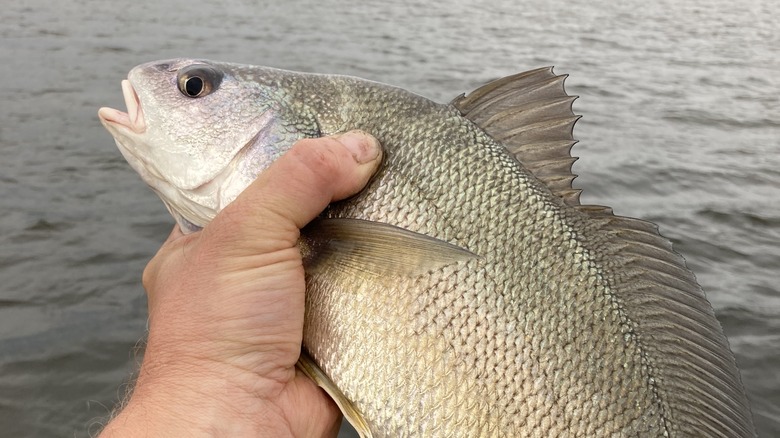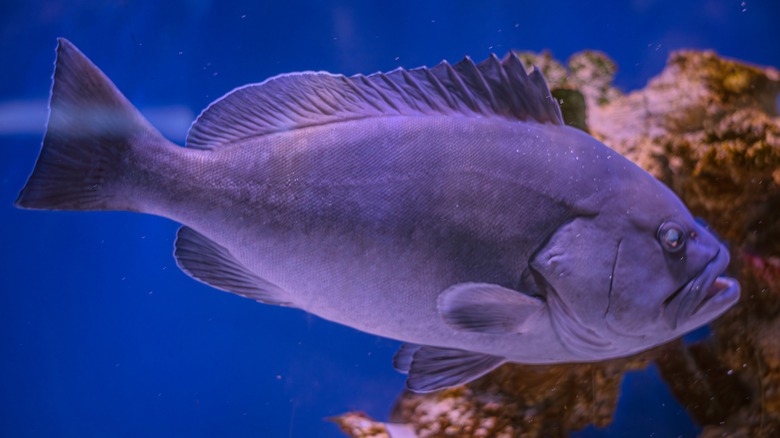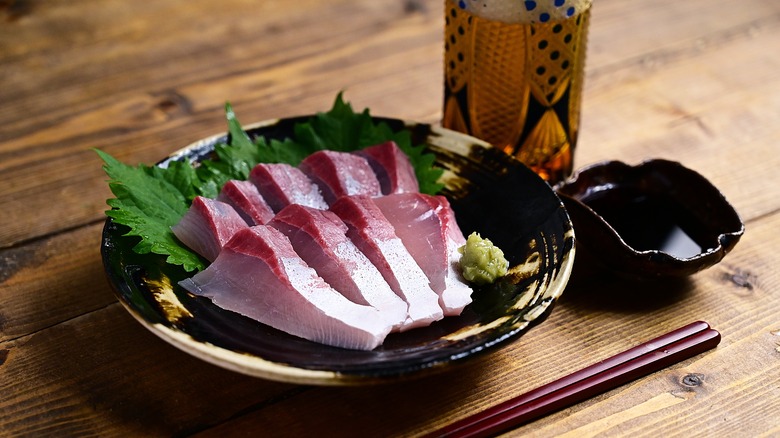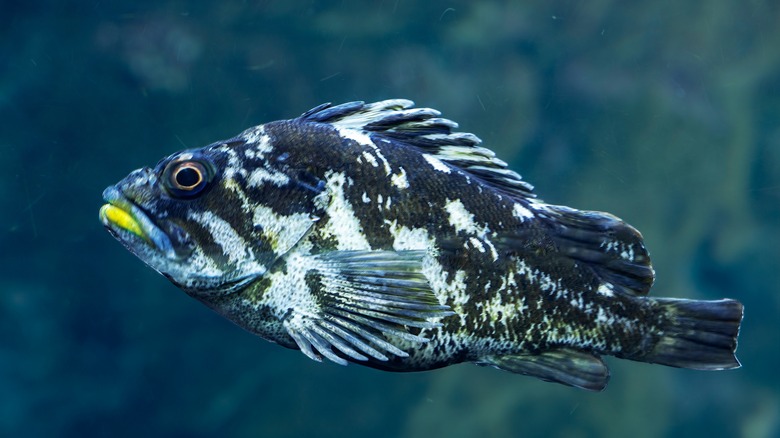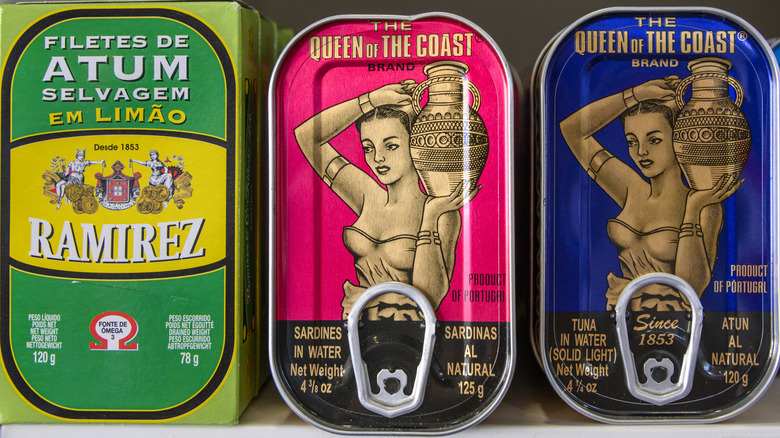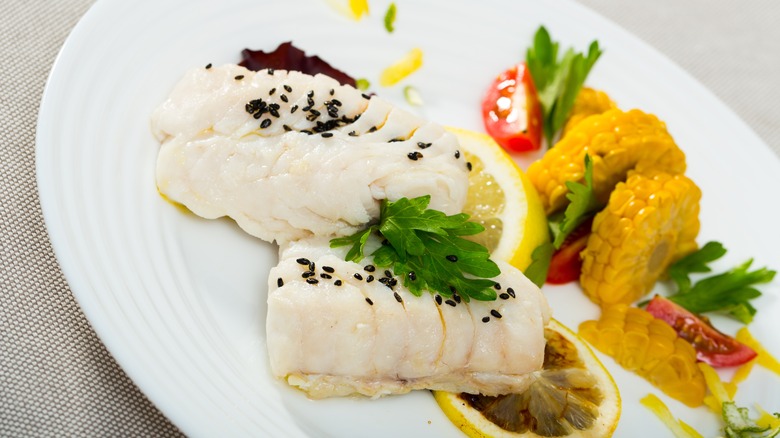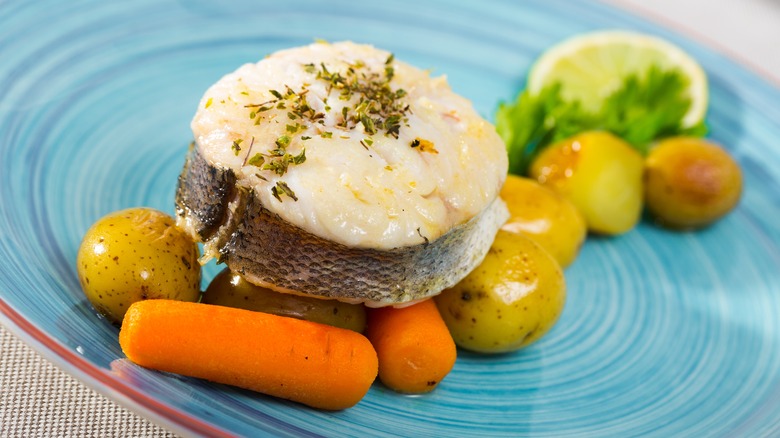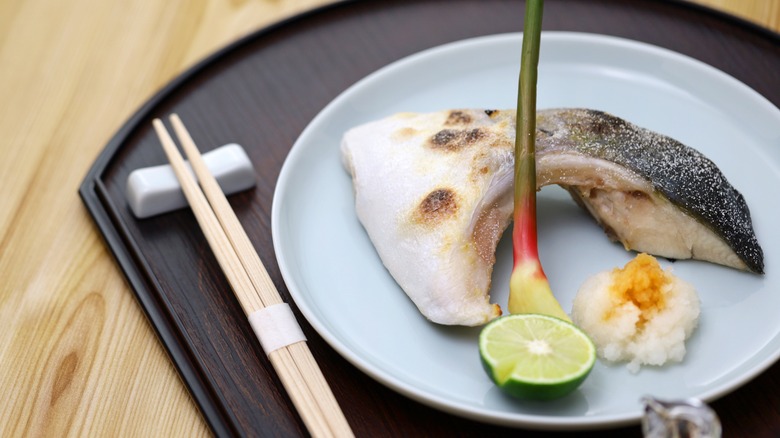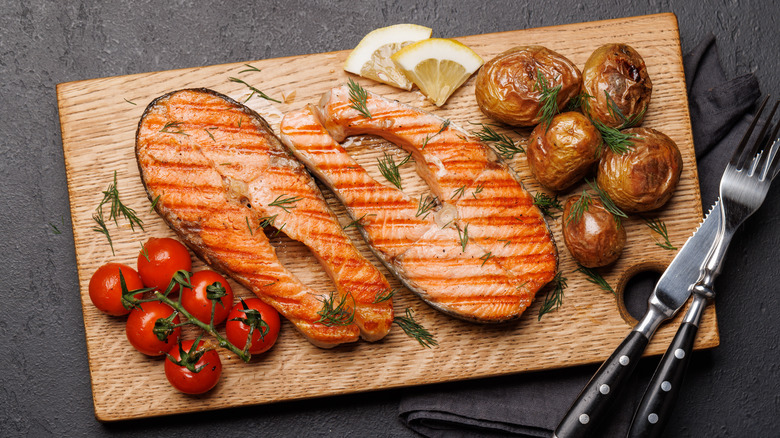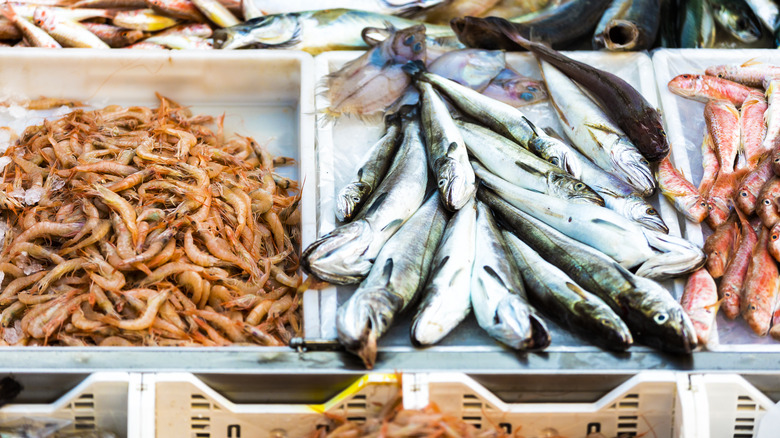13 Inexpensive Fish You Can't Afford To Overlook
Once upon a time, believe it or not, fresh fish was the protein of choice for the frugal and cash-strapped. Alas, those days are long gone. "In recent years, it's likely becoming the most expensive protein you can buy, which I'm not happy about," said Carl Fantasia, a third-generation fishmonger and owner of New Deal Fish Market in East Cambridge, Massachusetts.
This means that for many of us, fish is more of a special-occasion treat than a weekday staple. So when we do buy it, we want to make sure we're getting good value. Fantasia warns, however, that affordability is a relative term when it comes to fish, and you should expect to invest a bit more fish (even the most affordable types) than you normally would for a main-dish protein. "When you compare it to even expensive chicken, it's still more expensive," he said. To help you find great fish that fits into your budget, we asked Fantasia and several other experts –- Jared Garner, chief scallop officer at FishNook Tinned Seafood; Eli Kirshtein, culinary director of Inland Foods; Vitaly Paley, James Beard Award-winning chef and culinary ambassador for Blue Ocean Mariculture; Charlie Siebenberg, CEO and co-founder of the aquaculture firm AQQUUA; and Jeff Josenhans, a passionate fisherman and food and beverage director at Intercontinental San Diego –- for their suggestions. The big takeaway from their advice? Choosing less-expensive fish doesn't mean compromising on flavor. These are the fish and fish cuts they recommend.
Bluefish
Just as you can save money at the supermarket by buying store brand rather than name brand products, you can save at the fish market by seeking out lesser-known fish. Bluefish is among the unsung fish types Eli Kirshtein enjoys. Along with other under-the-radar fish, bluefish, Kirshtein shared, "offer great value as they are not as sought after as their pricier cousins like salmon, halibut, and tuna. They may not be household names, but in no way are they inferior fish."
Bluefish is a firm fish, a bit darker and richer than typical white fish, that cooks up with big flakes. Its richness and strong flavor can be overwhelming for some eaters, but its powerful personality also makes it a good partner for bold accompaniments such as an aioli, a Vietnamese-style caramel sauce, or a mustard sauce. It's definitely a fish for fish-lovers, so if you consider yourself a member of this club, remember to look for bluefish during the summer months, when they are most abundant.
Mackerel
If you're a fan of boldly flavored fish, keep your eyes open for fresh mackerel. Not only are they deeply flavorful, they can be surprisingly affordable. "When mackerel are running in the spring and fall, when they're running in abundance, that's a relatively inexpensive fish," Carl Fantasia said. "It's very cheap," he continued. "We're selling them $6.99 a pound whole, and we'll clean them up any way you want, which also includes filleting if you want us to fillet them."
Mackerel, like bluefish, contain more fish oil and fat than milder fish varieties, which gives them a more forward, assertive flavor. Because of this, Fantasia recommends grilling or broiling them. "I like to get a really high heat with it," he said. To offset and balance its richness, he recommends serving mackerel with an equally punchy sauce, such as a lemon-parsley sauce, a Japanese-style ponzu sauce with yuzu juice, or a tangy sauce enlivened with ginger and scallions.
Drum
Yes, drum is the name of a fish as well as a percussion instrument –- and according to Eli Kirshtein, if you're seeking flavorful yet affordable fish, drum is well worth a try. It's a mild, firm white fish that takes well to straightforward seasoning and cooking methods. "For a healthy option, baking in parchment paper with vegetables and olive oil is a great one-pan meal," Kirshtein said. "[It's] also delicious on the grill or pan-roasted with a simple butter sauce."
This underappreciated fish got its unusual name for a reason: Fish in the drum family –- which include both freshwater and marine species –- are known for their loud, drum-like underwater calls, created by muscle vibrations against their swim bladders. And while commercial fishermen historically dismissed drum as undesirable bycatch (which could be why it's relatively affordable), recreational anglers consider drum to be worthy adversaries, not to mention a tasty reward after a long day on the water.
Skate wing
When seeking out affordable fish, it pays to stray off the beaten path. A type you've never considered eating may become your new favorite. For example, skate wing –- the fleshy fins of certain types of rays –- are a well-known delicacy in France, but little known in the U.S. And while a skate may not look like a conventional fish either in the water or on the plate (the wings have long, thin pieces of cartilage rather than bones), its firm, flavorful white flesh hits all the right notes for fish lovers. "[It's] one of those unknown species of fish that people that aren't informed might thumb their nose at, but you can save some money there," Carl Fantasia said.
So what do you do with skate wings, should you be lucky enough to find them? A traditional French treatment for skate wings is to serve them with a sauce featuring brown butter (that is, butter, that's heated until it starts to toast and darken). Other flavorings that can accent the sauce include white wine and/or capers.
Farmed grouper
Responsibly farmed fish can be another good option if you're trying to save money. "Farmed grouper is a fantastic option that many people are overlooking," said Charlie Siebenberg. "It's sustainable, affordable, and readily available." It's also delicious. "Farmed grouper has a mild, slightly sweet flavor with a firm, flaky texture, making it a versatile alternative to more common fish like salmon or wild snapper," Siebenberg added.
Because of its gentle flavor, good-quality grouper doesn't need a lot of embellishment –- the best cooking methods allow its natural flavor to shine through. And an added advantage, such preparations are easy to pull off at home. "I highly recommend pan searing our ASC [Aquaculture Stewardship Council]-certified farmed grouper," Siebenberg said. "A simple preparation involves marinating the fillets in olive oil, lemon juice, and herbs, and finishing it in the oven until just cooked through. This method preserves the fish's natural sweetness and results in a healthy, delicious meal."
Hawaiian kanpachi
If you're concerned about sustainability as well as affordability when shopping for seafood, farmed Hawaiian kanpachi is a good choice. "Sustainably farmed fish like Hawaiian kanpachi will always be more affordable than targeted wild species like salmon or tuna," Vitaly Paley explained. "It is also very consistent in pricing, which makes it easy to budget for. The supply of sustainably farmed fish is also much more reliable and dependable throughout the year, as it is harvested and not caught."
Even better, kanpachi is tasty and versatile enough that you won't feel like you're missing out on other fish. "Raw or cooked, it's a stunner," Paley said, adding that the fish's firm, pink flesh lends itself to a wide range of preparations and cooking styles –- or even no cooking at all. "It is fantastic as sashimi, sushi, ceviche, poke, or any other raw fish recipe. It is also buttery, mild, and simply delicious when cooked. It has a perfect natural fat content which is clean and light tasting, firm, flaky, and mild in flavor." Because of its richness, Paley adds that kanpachi also stands up well to bold flavors, making it a great addition to spicy fish tacos or a fish sandwich.
Rockfish
Serious food lovers know that lesser-known foods, from wines and cheeses to fruits and vegetables, can be just as delicious as their better-known relatives, if not more so. The same holds for fish: Not only can less-familiar varieties taste amazing, they can often be had at a more affordable price point. For instance, Jeff Josenhans recommends west coast rockfish. "There are so many types of groundfish found off the Pacific coast that are not only delicious to eat but well managed in terms of the sustainability of the fishery itself," he said.
San Diego-based Josenhans can find rockfish close to home –- literally. The small, stocky fish live close to shore, and as their name implies, favor oyster reefs and rocky areas. "Rockfish are in general a white, somewhat firm flaky fish but can vary depending on species," Josenhans said. "There are nearly 100 different species off the west coast and I suggest you try as many as you can. If you see a label that just says 'rockfish,' ask what type of rockfish you are purchasing." He adds that they're so flavorful they need only simple seasoning. "I prefer my rockfish pan fried in butter, with some garden herbs and fresh potatoes, maybe a pan sauce with capers and lemon. Good fish doesn't need much to taste delicious," he said.
Tinned fish
Yes, we know you already have a can of tuna in your pantry. But today's canned fish is more than just a weekday lunch standby: It can also be a company-worthy treat that's relatively easy on your budget. "Over the last few years the U.S. has been experiencing a surge in tinned fish, a.k.a conservas, varieties from Spain and Portugal," Jared Garner said. These cans feature sustainably caught seafood that's hand-packed and finished with distinctive flavorings such as escabeche sauce (a vinegar-based marinade) or spiced olive oil. While pricier than typical supermarket tuna, these treats can go a long way as part of a charcuterie platter or as special-occasion appetizers.
Supermarkets also offer some good choices for tinned fish. "If you're looking for affordable protein options that make a quick meal, simply look for what's on sale in the grocery aisle and give it a shot," Garner suggested. "If you're not thrilled by the look of what you open from the grocery store, hiding it under some tasty kimchi, fresh veg, and other goodies on a rice bowl can bring together some awesome flavor." If you're willing to invest a bit more for extra quality at the supermarket, Garner recommends Tonnino tuna in glass jars and Bela sardines. Garner also recommends the smoked trout and lightly smoked salmon from Trader Joe's, which "both offer some great flavor in a relatively affordable package."
Hake
As the old saying goes, there are many fish in the sea –- and among these may be a more affordable substitute for your favorite special-occasion fish. For instance, if you're a fan of firm, white fish such as cod or haddock, Carl Fantasia shares you can save a few dollars by seeking out hake instead. The catch is you may need to seek it out at a specialty seafood shop. "A lot of the larger stores aren't going to carry it," Fantasia said.
If your inner fish snob is worried that hake's relative affordability means it's somehow inferior to cod or haddock, Fantasia can offer some perspective: While hake is mostly unknown and thus more affordable in the U.S., this is not the case in other parts of the world, where it's wildly popular. "If you go to Spain, it's more expensive," he said. "They know that fish very well."
Pollock
When it comes to tasty fish, looks aren't everything. While popular varieties such as cod and salmon are known for their characteristically striking colors –- pure white or deep pink –- other, visually duller fish can be just as flavorful, not to mentioned more affordable. One such fish, which Carl Fantasia recommends, is pollock. "It's light white and flaky, but it's got a slightly darker, more pinkish, grayish flesh than your haddock or cod," he said. "So people might get turned off by that."
But if you can look past the color, you can enjoy flavorful fish for significantly less than you'd pay for better-known varieties. "You could find fillets of that at a reputable fish market for under $12 a pound," Fantasia said. "When you compare that to, say, cod, which is in greater demand and more overfished, that could be anywhere from $15 to $20 a pound for skinless cod fillets." If you have a favorite recipe for cod, you can use pollock in its place, but bear in mind that pollock has a more delicate texture and may fall apart more easily.
Fish collars
For those who have their hearts set on salmon or another popular-but-pricy fish, a smart option is to seek out less-common cuts. While most people go for pretty, neat filets, a lot of fish still remains after the filets have been cut off –- and some of these leftover bits make seriously good eating. "We sell the collars of the salmon, which is the part of the fish right behind the head, which two fins are attached," Carl Fantasia said. "But it's got a bone in it, the collar. [The] flesh is very, very delicate, tender. It does have a few small bones to be careful of as well, but it's a lot less expensive than the fillets of salmon."
Jeff Josenhans agrees. "Collars are a great and affordable cut that is often overlooked but can be a delicious appetizer," he said. And Fantasia offers some tips for cooking them: "Put a good char on because it has a higher fat content and things that have higher fat I think do better with higher heat," he said.
Salmon steaks
Another money-saving option for enjoying larger fish is to seek out steaks rather than fillets. "There are salmon steaks, bone-in steaks, which are more common at the supermarkets than collars, [and] I believe, generally cheaper," Fantasia said. He explained that in the seafood world, the term steak refers to cross-wise slices from the fish's body which include the skin, spine, and other bones. "I think they're tastier when you're cooking it on the grill or even in the oven."
As a bonus, Fantasia said, salmon steaks hold together well, which makes them a great choice if you love to grill fish. Both the bones and skin help keep the steaks intact and can prevent them from flaking or falling apart when you flip them. And while some diners may find these bits unattractive or off-putting, they also contribute a lot of flavor, making salmon steaks a treat for serious fish lovers. Grilled salmon steaks match well with a range of flavorings, from Italian herbs to maple glazes to creamy mustard sauces.
Fish bellies
If you're a fan of sushi topped with toro –- melt-in-your-mouth, fatty tuna belly –- you'll be delighted to know that tender, rich fish bellies can be among the more affordable fish cuts. This is because historically, the belly strips were the edges left over after the more-sought-after filets were cut from the fish. So if you buy belly strips, you'll end up not with plump, pretty fillets or steaks, but thin, irregularly shaped strips of fish. They may look like scrap pieces, but don't let that put you off — behind their plain looks is a wealth of flavor. "Sometimes we'll sell what are called belly strips, which are the belly edges that have some connective tissue, but once you roast them, they melt in your mouth," Carl Fantasia said. Jeff Josenhans is also a fan of fish bellies. "People are familiar with tuna belly, but other species of larger fish also have belly meat that is fatty and flavorful. All worth exploring!" he said.
So once you've found some nice fish bellies, how should you prepare them? The short answer is any way you like. They're surprisingly versatile and are good glazed in teriyaki sauce, simmered in soup, or fried up tempura-style. They're also fun to smoke on a grill or use in ceviche.
Bonus tips and smart ways to shop for fish
Our experts also shared some useful tips for shopping for fish on a budget. Carl Fantasia and Jeff Josenhans both agreed that unusually low prices should be a red flag for buyers. "I like to say if it's too good to be true, it's too good to be true," Fantasia said. "You need to be suspect of that." Josenhans likewise warns that bargain-barrel fish may end up being a disappointment, especially if it's not local. "Any cheap fish that's travelled the world, such as southeast Asian farmed tilapia, is generally something to avoid," he said.
Conversely, Josenhans explained, your odds of finding good, fresh fish at fair prices are best close to the source. "Fish markets or straight from the fishermen/place of receiving is always going to be the best place to buy your fish," he said. Eli Kirshtein shares another secret: "Never overlook your local, internationally-focused markets. They often source from the same companies as the larger retailers and offer more diverse options for customization," he said.
Finally, to ensure the long-term availability (and affordability) of good-quality fish, Vitaly Paley advises consumers to seek out sustainable options. "I recommend making a habit of consulting with the Aquaculture Stewardship Council for all farmed fish and seafood, Marine Stewardship Council for all seafood caught in the wild, and Monterey Bay Aquarium Seafood Watch for overarching information on making an educated decision on which fish or seafood is safe to buy," Paley said.
